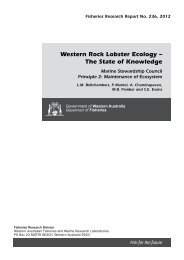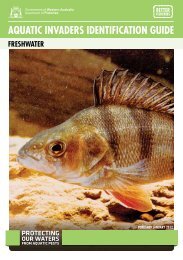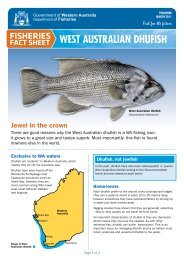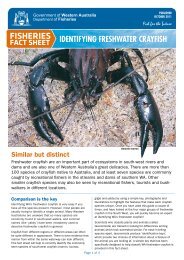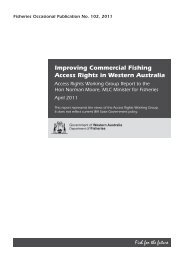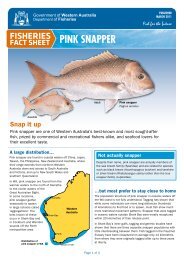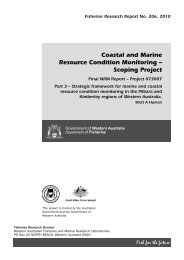Assessment of gonad staging systems and other ... - CiteSeerX
Assessment of gonad staging systems and other ... - CiteSeerX
Assessment of gonad staging systems and other ... - CiteSeerX
Create successful ePaper yourself
Turn your PDF publications into a flip-book with our unique Google optimized e-Paper software.
APPENDIX B. Initial macroscopic <strong>staging</strong> system used in the analysis <strong>of</strong> S. commerson<strong>gonad</strong>s. F = female, M = male.J (Juvenile)F1 (Virgin/immature)F1a (ImmatureDeveloping)F2 (Mature resting)F3 (Developing)F4 (Developed)F5a (Pre-spawn)Gonad is a small, translucent pink ribbon lying imperceptibly along thedorsal wall <strong>of</strong> the peritoneal cavity. Sex <strong>of</strong> the fish cannot be determined.Ovaries are small <strong>and</strong> usually translucent pink, apricot or ivory in colour(more opaque <strong>and</strong> red in unbled fish). In smaller females the ovaries areflattened, flaccid, <strong>and</strong> relatively inconspicuous, but they become rounded<strong>and</strong> firmer with a distinct lumen as the fish approaches maturity. Theoocytes are microscopic resulting in a smooth, uniform appearance to theovarian tissue. Yellow-brown bodies are uncommon.Used to stage ovaries immediately prior to the spawning periodwhich have the features <strong>of</strong> a virgin (F1) ovary but which also containcortical alveoli stage oocytes.Soon after completion <strong>of</strong> spawning activity the resting ovaries appearflaccid with prominent exterior blood vessels. Internally the lumen is large.Few if any oocytes can be seen whilst yellow-brown bodies are distinct(sometimes very common) <strong>and</strong> blood clots may also be present. As timesince spawning increases, the ovaries become progressively rounder <strong>and</strong>firmer as the <strong>gonad</strong> wall contracts <strong>and</strong> thickens <strong>and</strong> the ovarian tissuedevelops. Yellow-brown bodies may be evident for sometime <strong>and</strong> are themain feature used to distinguish mature resting from virgin ovaries. Colouris typically semi-translucent rose, pink or ivory, although in unbled fish theovaries are <strong>of</strong>ten red.Ovaries may still have a semi-translucent, rose or pinkish colour (red ifunbled), but become larger <strong>and</strong> lose translucency as the oocytes becomeopaque. This gives the ovarian tissue a slightly speckled or granularappearance. Exterior blood vessels become more prominent during thisstage. It is <strong>of</strong>ten difficult to distinguish late developing from earlydeveloped ovaries.Early in this stage the ovaries appear semi-translucent <strong>and</strong> speckledbecause there are still many translucent immature oocytes. As moreoocytes develop <strong>and</strong> turn opaque the ovaries become large, rotund <strong>and</strong>opaque with prominent blood vessels. The opaque oocytes are visiblethrough the thin <strong>gonad</strong> wall <strong>and</strong> the colour is typically pale yellow orapricot. Towards the end <strong>of</strong> the reproductive period the ovaries becomemore bloodied <strong>and</strong> flaccid as oocyte reserves are depleted duringspawning, <strong>and</strong> yellow brown bodies may become more common <strong>and</strong> thelumen larger.Ovaries are very large <strong>and</strong> swollen, although towards the end <strong>of</strong> thereproductive season they may become somewhat flaccid. Colour is apricotto peach with a prominent network <strong>of</strong> external blood vessels. Thepresence <strong>of</strong> translucent hydrated oocytes gives the ovaries a distinctivespeckled or granular appearance through the thin <strong>gonad</strong> wall. However, ifthe oocytes are still in the migratory nucleus stage <strong>of</strong> development theovary may be difficult to distinguish from the developed stage. This stageis distinguished from the next (5b) by the lack <strong>of</strong> hydrated oocytes withinthe lumen.28 Fish. Res. Rep. West. Aust.2001, 136, 1-32



